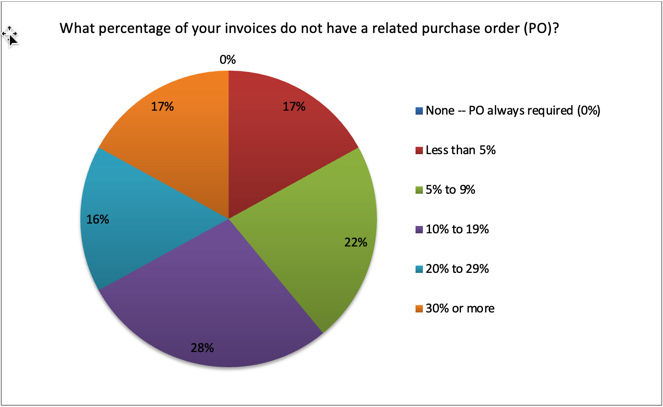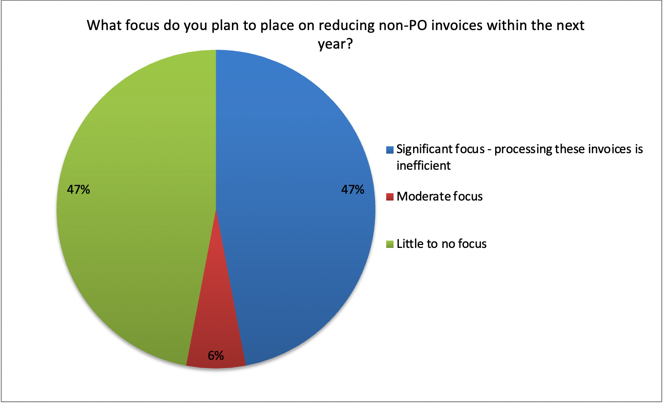Processing Non-PO Invoices in Accounts Payable
Introduction
While many companies have a well-designed process for handling invoices associated with purchase orders (POs), the non-Purchase Order (non-PO) related invoices can often be much more challenging and the cause of many exceptions. These invoices often arrive at the location making the purchase, complicating the process for approval and invoice submission for processing at a central location. While having a robust Purchasing Card process can significantly reduce non-PO invoices, it is often only part of the solution for streamlining how purchases made without a Purchase Order are processed.
Company Experience
A Peercast discussion in our Accounts Payable (P2P) research area featured a $2B diversified brand manufacturing company sharing their journey to streamline their non-PO invoice entry process. With a successful Purchasing Card program in place, there remained multiple types of invoices that were received locally that did not have an associated PO.
The spend categories associated with these non-PO invoices included 1) legal payments, 2) tax payments, 3) utility payments, and 3) purchases under a $2,000 threshold where Purchasing Cards were not accepted. The previous process was to have the approver stamp the invoice using a physical red ink stamp with a unique 3-digit number assigned to the approver, with the approver manually recording in pen on the ink stamped image the information required for processing, with a physical signature on the stamp image required.
In this process, the flow included the vendor sending the invoice directly to the approver, the approver stamping and coding the invoice, followed by sending the invoice to Accounts Payable using interoffice mail. Accounts Payable would then enter the 3-digit number and other details required for processing into SAP. The number would be automatically compared to a custom table in SAP, and if the invoice total amount was equal to or less than the limit assigned to the stamp number issued to the approver, the invoice entry would be complete.
The digital transformation of this manual process started with the physical scanning of the documents locally with the invoice and a separate coding form scanned and submitted to Accounts Payable by email. The coding could be completed by key entry by the approver with no handwriting or signature needed. In this first phase the invoice processers would key data from an image of the documents.
In the next phase of the project, an online form and workflow for preparers and approvers was created, that provided vendor and General Ledger account number validation, with the ability for users to save templates to simplify the process for similar invoices.
The final step is the full automation of non-PO invoice entry, where the preparer completes the form online and sends it for approval, the approver approves or rejects, and if approved a Robotic Process Automation software enters the invoice data into SAP, SAP creates the voucher number, and then to complete the process Robotic Process Automation software sends the invoice with invoice meta data to document management for storage electronically.
For details, Peeriosity members are encouraged to sign into the members’ area to view the complete presentation and listen to the recorded Peercast.
iPolling Results Review
A Peeriosity poll created using iPolling provides insight to the volume of non-PO invoices at Peeriosity member companies, and the emphasis at Peeriosity member companies expect to make during the next year to reduce the volume of non-PO invoices. The results indicate that while none of the participating companies always require a Purchase Order, it’s almost an even spread between those with a volume of non-PO invoices of less than 5% through those with a volume of non-PO invoices of 30% or more. Here are the details:

The second poll question asked Peeriosity members to comment on their plans to reduce non-PO invoices within the next year. Interestingly, 47% indicated they will have a significant focus on reducing non-PO invoices and another 47% will have little to no focus, with the balance of 6% expecting to have a moderate focus on reducing non-PO invoices. When you look more closely at the data to see the relationship between the two responses, those indicating a significant focus are all companies with high levels of non-PO activity, and those with little to no focus are all companies with a low volume of activity.

Here are some of the comments from members:
- Although in North America the non-PO volume is very minimal in EMEA we do have concerns, thus there is a big push for PO compliance in EMEA.
- There is only a small category now of services/goods that can be accepted as non-PO. One of the biggest categories was Logistics invoices. We are in the process of moving to a Freight Bill Audit Pay provider which will move this category to an external 3rd party which will reduce the number of non-PO. Businesses can focus on the remaining to reduce non-PO categories.
- Our EMEA PO compliance (using August 2021 data) shows No POs 39% of the time, and POs created after the fact (after the invoice shows up) 14% of the time. In N.A., we have very high PO compliance well above the 90% level. So blended we are non-compliant about 25% of the time. We have a cross-functional PO Compliance team working in the EMEA region to improve their percentages, and we have a new global policy requiring POs to aid in the compliance area.
- While 33% of our invoices do not have a PO, we have various supplier types that are exempt from requiring a PO. For the rest of the supplier types that do require a PO, we have less than 1% without a PO (processed as non-PO).
- Automation of the non-PO invoices is our goal.
Closing Summary
Process improvement for Accounts Payable requires a detailed understanding of the nature of the underlying transactions with a focus on changing the transactions as much as possible to the most efficient and effective process. For example, moving volume to Evaluated Receipts Settlement, implementing EDI with electronic notices for automated processing, requiring Purchase Orders where appropriate, and shifting low dollar volume to Purchasing Cards. With advanced solutions now available, it is also possible to eliminate the manual effort required for processing non-PO invoices, to the extent that this category can’t be reduced or eliminated by using other processing channels.
How much activity does your company have for non-PO invoices? For these types of transactions, how automated is the process and where are the constraints or bottlenecks where improvement is required? How much of a focus will your company place on improving the non-PO process during the next year?
Who are your peers and how are you collaborating with them?
______________________________________________________________________
“Peercasts” are private, professionally facilitated webcasts that feature leading member company experiences on specific topics as a catalyst for broader discussion. Access is available exclusively to Peeriosity member company employees, with consultants or vendors prohibited from attending or accessing discussion content. Members can see who is registered to attend in advance, with discussion recordings, supporting polls, and presentation materials online and available whenever convenient for the member. Using Peeriosity’s integrated email system, Peer MailTM, attendees can easily communicate at any time with other attending peers by selecting them from the list of registered attendees.
“iPolling” is available exclusively to Peeriosity member company employees, with consultants or vendors prohibited from participating or accessing content. Members have full visibility of all respondents and their comments. Using Peeriosity’s integrated email system, Peer Mail, members can easily communicate at any time with others who participated in iPolling.
Peeriosity members are invited to log into www.peeriosity.com to join the discussion and connect with Peers. Membership is for practitioners only, with no consultants or vendors permitted. To learn more about Peeriosity, click here.

